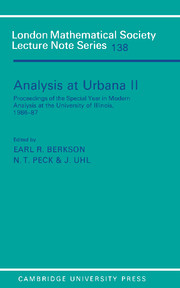Book contents
- Frontmatter
- Contents
- Acknowledgements
- PREFACE
- The C1contractions
- Factorization theorems for integrable functions
- Spectral decompositions and vector-valued transference
- Vector-valued Hardy spaces from operator theory
- Restricted invertibility of matrices and applications
- The commuting B.A.P. for Banach spaces
- The minimal normal extension of a function of a subnormal operator
- Two C*-algebra inequalities
- The generalised Bochner theorem in algebraic scattering systems
- Differential estimates and commutators in interpolation theory
- A survey of nest algebras
- Some notes on non-commutative analysis
- Some remarks on interpolation of families of quasi-Banach spaces
- An application of Edgar's ordering of Banach spaces
- Martingale proofs of a general integral representation theorem
Martingale proofs of a general integral representation theorem
Published online by Cambridge University Press: 05 September 2013
- Frontmatter
- Contents
- Acknowledgements
- PREFACE
- The C1contractions
- Factorization theorems for integrable functions
- Spectral decompositions and vector-valued transference
- Vector-valued Hardy spaces from operator theory
- Restricted invertibility of matrices and applications
- The commuting B.A.P. for Banach spaces
- The minimal normal extension of a function of a subnormal operator
- Two C*-algebra inequalities
- The generalised Bochner theorem in algebraic scattering systems
- Differential estimates and commutators in interpolation theory
- A survey of nest algebras
- Some notes on non-commutative analysis
- Some remarks on interpolation of families of quasi-Banach spaces
- An application of Edgar's ordering of Banach spaces
- Martingale proofs of a general integral representation theorem
Summary
Abstract
Let K be a line-closed measure-convex bounded subset of a Banach space so that every relatively closed separable subset of K is analytic. By constructing certain martingales it is proved that if K has the Radon-Nikodým property, then for every k0 in K there is a separable relatively closed convex subset K0 of K and a Borel probability measure μ supported on the extreme points of L, for every relatively closed separable convex subset L of K with L ⊃ K0, so that k0 is the barycenter of μ; μ is uniquely determined by k0 if and only if K is a simplex.
Introduction.
We give here a self-contained exposition of various known integral representation results, via the general theorem stated in the abstract. Both the existence and uniqueness parts of the theorem are obtained through the construction of certain martingales. Our main arguments and formulations are thus probabilistic in nature.
For the sake of orientation, we first recall the following representation result, due to E.G.F. Thomas [26].
Theorem.Let K be a closed bounded measure-convex Souslin subset of a locally convex space and assume that K has the Radon-Nikodým property (the RNP). Then for every x in K, there is a Borel probability measure μ supported on the extreme points of K so that x is the barycenter of μ; this μ is uniquely determined (for every given x) if and only if K is a simplex.
- Type
- Chapter
- Information
- Analysis at Urbana , pp. 294 - 356Publisher: Cambridge University PressPrint publication year: 1989



